The first time I tasted mushroom miso soup, it felt like a warm hug. The deep flavor took me straight to a cozy Japanese kitchen. It was like a taste of tradition in every spoonful. Miso Mushroom Pasta offers a similarly comforting experience, blending the rich umami of miso with the earthiness of mushrooms in a creative twist on a classic dish.
Making the perfect mushroom miso soup is an art that takes only 25 minutes. It's perfect for anyone, whether you're busy or love cooking. This easy recipe will make your kitchen a place of delicious flavors. Pellet Smoker enthusiasts can also explore how to enhance the soup's flavor by incorporating subtle smoky notes for an elevated experience.
Miso soup is all about umami, the savory taste that excites your senses. Adding mushrooms gives it a rich, earthy flavor. Each bowl is packed with 16 grams of protein and just 316 calories. Chicken and Shrimp can also be added to the soup for an extra layer of flavor and a boost in protein, making it even more satisfying.
Are you ready to learn five easy ways to make mushroom miso soup? Your taste buds and body will love this journey into Japanese cooking. Pellet Grill enthusiasts can also experiment with adding a touch of smokiness to the ingredients, creating a unique twist on this classic dish.
Table of contents

Understanding the Magic of Miso Soup Basics
Explore the amazing world of miso, a fermented gem that turns your vegan soup into a work of art. This ancient Japanese treasure adds depth, complexity, and health benefits to your homemade broth. Prime Rib Seasoning can also complement the soup, offering a creative way to blend bold, savory flavors with the delicate richness of miso.
Miso is more than a seasoning; it’s a living food with a long history. The fermentation process makes it a flavor and nutrition powerhouse, enhancing any dish.
Types of Miso Paste for Soup Making
When making your vegan soup, knowing about miso varieties is key. Each type has its own special qualities:
- White Miso (Shiro Miso): Mild and slightly sweet, great for light homemade broths
- Yellow Miso (Shinshu Miso): Balanced flavor, perfect for everyday cooking
- Red Miso: Strong and salty, ideal for hearty soups and stews
Essential Equipment and Tools
To make the perfect miso soup, you need simple tools but precise techniques. You’ll need:
- A fine-mesh strainer
- Whisk
- Heavy-bottomed pot
- Cutting board
Basic Ingredients Overview
Your vegan soup comes to life with the right ingredients. Key components include:
- Vegetable-based dashi
- Silken tofu
- Seaweed
- Fresh or dried mushrooms
"Miso is not just an ingredient; it's a journey of flavor waiting to be explored in every spoonful."
The secret to a great homemade broth is understanding these basic elements. Treat each ingredient with care.
The Secret to Creating the Perfect Dashi Base
Dashi is the heart of Japanese soup, bringing out a deep umami flavor. It turns simple ingredients into a work of art. Crispy Chicken Fries can be served as a delightful side dish, adding a crunchy texture to complement the warm and savory soup. To start making perfect miso soup, you need to understand this key stock.
Traditional dashi uses kombu (dried kelp) and katsuobushi (dried bonito flakes). Making it right needs focus and the right amounts.
- Use 276 grams of kombu
- Combine with 10,121 grams of water
- Steep kombu for 72.5 minutes
- Maintain a temperature around 72°C
For a quicker option, try instant dashi granules. They capture the essence of traditional dashi but save time.
"The soul of Japanese cooking lies in its broth" - Traditional Japanese Culinary Saying
Vegetarian cooks can make dashi with dried shiitake mushrooms. This way, everyone can enjoy the rich umami flavor. The trick is to find the right balance of ingredients for depth and complexity.
| Ingredient | Quantity | Purpose |
|---|---|---|
| Kombu | 20cm x 10cm per person | Provides base umami flavor |
| Katsuobushi | 312.51 grams | Adds depth to broth |
| Water | 10 cups | Extraction medium |
Your dashi is the base for an amazing Japanese soup. Whether you go traditional or modern, mastering this will boost your cooking skills. It will take your taste buds on a trip to Japan.
Selecting and Preparing Mushrooms for Miso Soup
Starting a delicious mushroom dish begins with picking the right mushrooms. Mushrooms come in many flavors, textures, and health benefits. They can make your miso soup truly special.
Fresh Mushroom Varieties to Explore
For your miso soup, consider these tasty mushroom options:
- Shiitake: Rich, meaty flavor with a smooth texture
- Enoki: Delicate and slightly crunchy, adds visual interest
- Oyster mushrooms: Tender with a subtle seafood-like note
- Button mushrooms: Mild flavor, great for beginners
Exploring Dried Mushroom Options
Dried mushrooms add a deep umami flavor to your soup. Porcini mushrooms are famous for their earthy taste. Soak dried mushrooms in warm water for 20-30 minutes before adding to your soup.
Cleaning and Cutting Techniques
Good preparation is crucial for flavor and texture. Here’s a quick guide:
- Gently brush off any dirt with a soft brush or damp paper towel
- Avoid washing mushrooms directly under water to prevent waterlogging
- Slice mushrooms uniformly for even cooking
- Remove tough stems from shiitake mushrooms before chopping
"The secret to a great mushroom soup lies in the quality and preparation of your mushrooms."
| Mushroom Type | Flavor Profile | Best Preparation Method |
|---|---|---|
| Shiitake | Rich, meaty | Slice thinly, remove stems |
| Enoki | Delicate, mild | Trim ends, use whole or cut into sections |
| Oyster | Subtle, seafood-like | Tear into smaller pieces |
By choosing and preparing your mushrooms well, you’ll make your miso soup a true delight. It will please your taste buds and senses.
Essential Ingredients for Authentic Mushroom Miso Soup
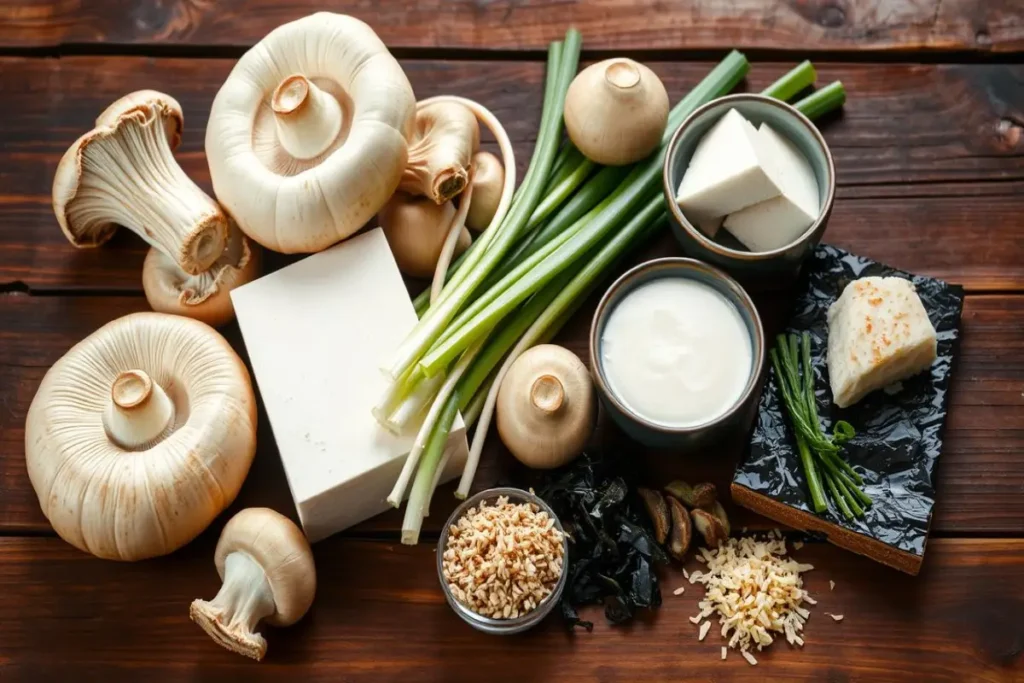
Making a tasty vegetarian comfort food like Japanese-inspired soup needs the right ingredients. These ingredients add depth and make your dish authentic. Filet Mignon Calories might not be relevant to this vegetarian dish, but understanding nutritional values helps you make balanced meal choices. Mushroom miso soup is special because of its simple yet powerful parts.
- Miso Paste: The heart of the soup, providing rich umami flavor
- Fresh mushrooms (shiitake or cremini recommended)
- Dashi stock or vegetable broth
- Soft tofu, cubed
- Wakame seaweed
- Green onions for garnish
White miso paste is a great choice for this soup. It’s mild and sweet, which goes well with mushrooms. Choose high-quality, fresh ingredients to make your dish even better.
"The secret to an authentic miso soup is balance and simplicity." - Traditional Japanese Cooking Wisdom
This soup is not only tasty but also very healthy. Each serving has about 202 calories. It also offers:
- 15g of protein
- 25g of carbohydrates
- 8g of fiber
- Rich in vitamins A and C
Pro tip: Always add miso paste at the end of cooking. This keeps its probiotic benefits and nutrients intact.
Step-by-Step Guide to Perfect Mushroom Miso Soup
Making a simple soup with homemade broth requires attention to detail. Your journey to making mushroom miso soup starts with learning the art of soup making.
The secret to a great homemade broth is in choosing the right ingredients and controlling the temperature. Here are the key steps to make a perfect mushroom miso soup.
Preparing the Dashi Broth
Start with a flavorful base for your soup. Your homemade broth is the key to a great miso soup.
- Choose the best kombu and bonito flakes
- Soak kombu in water for 30 minutes
- Take out kombu before the water boils
- Add bonito flakes and strain after 5 minutes
Adding Ingredients in Precise Order
The order in which you add ingredients is crucial. Follow these important steps:
- Sauté mushrooms first to boost flavor
- Add vegetables slowly
- Pour in dashi broth
- Add miso paste last
Temperature Control Techniques
Keeping the right temperature is key. It helps your miso soup keep its nutrients and taste.
| Stage | Temperature Range | Duration |
|---|---|---|
| Dashi Preparation | 160-180°F | 20 minutes |
| Mushroom Sautéing | Medium heat | 3-5 minutes |
| Miso Integration | Below boiling (140-160°F) | 1-2 minutes |
Pro tip: Never boil miso paste, as high temperatures destroy its probiotic benefits!
By following these steps, you’ll make a restaurant-quality mushroom miso soup at home. Remember, practice makes perfect, so don’t worry if it’s not perfect the first time.
Nutritional Benefits and Health Properties
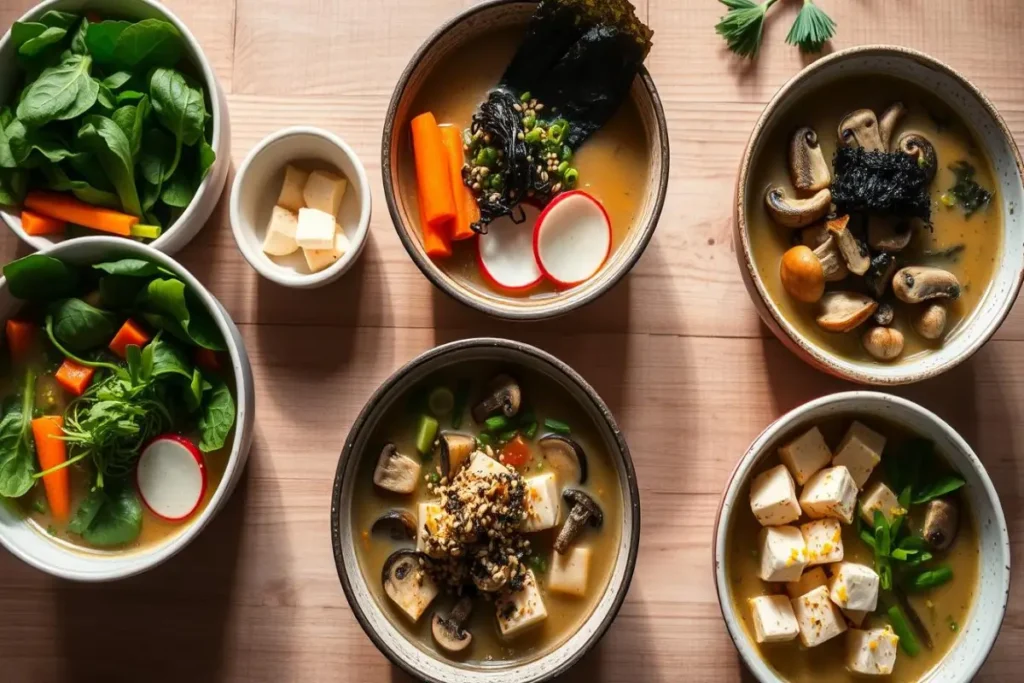
Exploring healthy soup recipes? Mushroom miso soup is a top choice. It’s not just tasty; it’s packed with health benefits that boost your wellness.
Miso is a nutritional powerhouse. Here are some key health stats:
- Only 30 calories per tablespoon
- 2.0g of protein per serving
- Rich in essential minerals like iron and zinc
- Contains beneficial probiotics for gut health
Mushrooms add even more to the soup’s nutritional profile. They’re full of vitamin D and compounds that boost your immune system.
"Food is medicine, and miso soup is a perfect example of nourishment in a bowl" - Traditional Japanese Wellness Philosophy
Looking for a low-calorie, nutrient-rich meal? This vegan soup is a great choice. Here are the health benefits:
| Health Benefit | Potential Impact |
|---|---|
| Digestive Health | Promotes beneficial gut bacteria |
| Heart Health | May reduce cholesterol levels |
| Cancer Prevention | Linked to potential reduced risk |
| Menopausal Support | Can alleviate hot flashes |
Whether you’re vegan or just looking for healthy soups, mushroom miso soup is a great choice. It’s not only delicious but also super nutritious.
Common Mistakes to Avoid When Making Miso Soup
Making the perfect homemade broth for miso soup needs careful attention. Knowing common mistakes can make your soup go from good to great.
Temperature Control Challenges
Getting the temperature right is crucial for miso soup. Boiling miso can harm its good bacteria and flavor. The ideal serving temperature is 167°F (75°C). But, never reheat it above 140°F to keep it nutritious.
- Avoid direct boiling after adding miso
- Steep miso at low temperatures
- Use a kitchen thermometer for precision
Ingredient Timing Mistakes
The timing of adding ingredients is key for a great broth. Overcooking mushrooms can make them lose texture and taste.
| Ingredient | Ideal Addition Time |
|---|---|
| Dashi | First 5 minutes |
| Mushrooms | Last 3 minutes |
| Miso Paste | Final 2 minutes |
Storage and Preservation
Proper storage is key to keeping your soup’s quality. Refrigerate leftover miso soup in a sealed container and eat it within 2 days.
"Miso soup is best enjoyed fresh, but careful storage can help preserve its delicate flavors." - Japanese Culinary Experts
- Refrigerate within 2 hours of cooking
- Store in glass or ceramic containers
- Do not freeze soup with tofu
Pro tip: Always taste and adjust seasoning before serving to ensure a perfect miso soup experience.
Customizing Your Mushroom Miso Soup
Make your Japanese-inspired soup your own by trying new things. Your mushroom dish can change to fit your taste and diet.
- Noodle Additions:
- Udon noodles (traditional choice)
- Soba noodles (nutty buckwheat flavor)
- Rice noodles (gluten-free option)
- Protein Boost Options:
- Soft-boiled eggs (5-6 minutes cooking)
- Tofu cubes
- Grilled chicken strips
- Vegetable Enhancements:
- Spinach (vitamin-rich)
- Bok choy (quick 1-2 minute blanching)
- Corn kernels
For spice fans, try chili oil or sriracha. Add miso paste last to keep its flavor and health benefits.
"Cooking is about personal expression - make this soup your own culinary canvas!"
Flavor Intensity Comparison
| Miso Type | Flavor Profile | Best Used For |
|---|---|---|
| White Miso (Shiro) | Mild, Slightly Sweet | Lighter Soups |
| Red Miso (Aka) | Salty, Robust | Hearty Dishes |
You can make your mushroom miso soup ahead of time. Store broth and mushrooms separately. It stays good in the fridge for up to 5 days, great for meal prep.
Pro tip: Experiment freely, but always add miso last to maintain its nutritional integrity!
Vegetarian and Vegan Adaptations
Turning mushroom miso soup into a vegan delight is easy. It doesn’t mean losing flavor or nutrition. With some creative tweaks, you can make it even better for plant-based diets.
Making miso soup vegan opens up new culinary adventures. The trick is to pick the right protein and dairy-free options. This keeps the soup rich and satisfying.
Plant-Based Protein Power
For vegan mushroom miso soup, pick protein-rich ingredients that taste great with the broth. Here are some top choices:
- Extra-firm tofu, cubed and lightly pan-fried
- Tempeh, crumbled or sliced
- Edamame beans for a vibrant green protein boost
- Seitan strips for a hearty texture
Dairy-Free Cream Alternatives
Getting a creamy texture in vegan soup is easy. Try these dairy-free options:
- Coconut milk for a rich, smooth base
- Cashew cream for a silky texture
- Blended silken tofu for added creaminess
"The beauty of vegan miso soup lies in its adaptability and endless flavor possibilities." - Japanese Culinary Expert
When making your vegetarian comfort food, use vegetable-based dashi. It replaces traditional bonito stocks. Kombu seaweed and dried shiitake mushrooms add a deep umami flavor to your vegan soup.
By using these adaptations, you’ll make a nutritious, tasty mushroom miso soup. It will please both vegan and non-vegan eaters.
Seasonal Variations and Ingredients
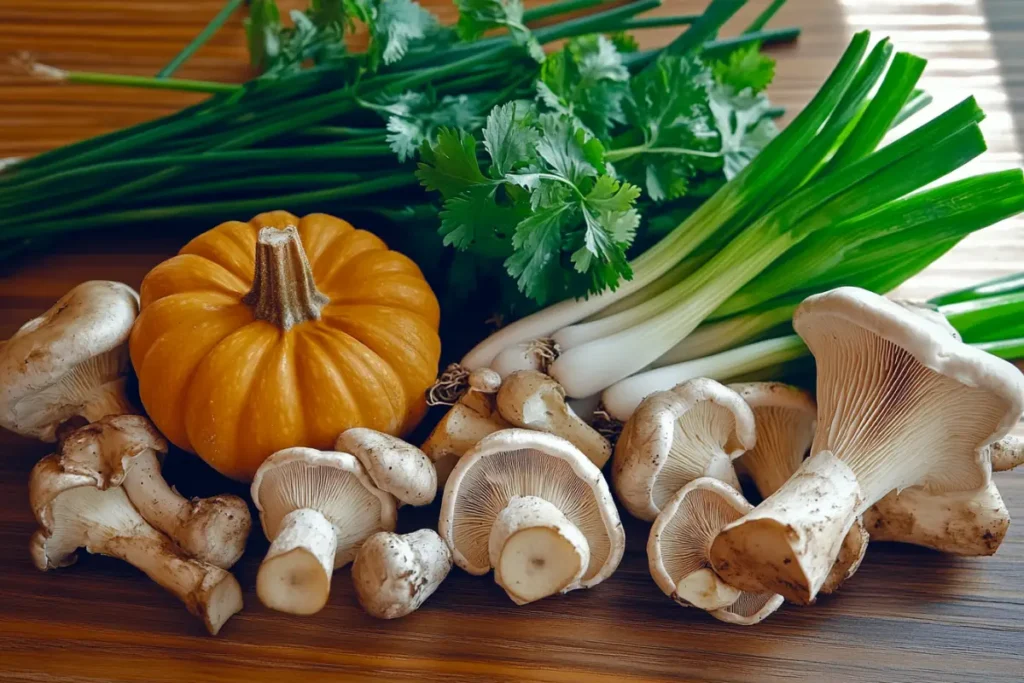
Making a healthy soup recipe that changes with the seasons can turn a simple dish into a journey. Each season brings its own mushrooms and ingredients. These can make your miso soup even better.
When making your seasonal mushroom miso soup, think about these great changes:
- Spring: Use light mushrooms like enoki and fresh shiitake for soft flavors
- Summer: Add fresh corn and tender oyster mushrooms for a bright taste
- Autumn: Add rich chanterelles and porcini mushrooms for depth
- Winter: Use hearty crimini mushrooms with sweet potato for warmth
Your seasonal miso soup can be very flexible. The secret is to pick fresh, quality ingredients that match each season’s special traits.
| Season | Recommended Mushrooms | Additional Ingredients |
|---|---|---|
| Spring | Enoki, Fresh Shiitake | Young green onions, tender herbs |
| Summer | Oyster, Button | Fresh corn, zucchini |
| Autumn | Chanterelles, Porcini | Root vegetables, sage |
| Winter | Crimini, Dried Shiitake | Sweet potato, kale |
"Seasonal cooking is about celebrating the ingredients nature provides at different times of the year." - Unknown Chef
Also, think about changing your miso paste with the seasons. White miso is great for spring and summer soups because it’s mild. Darker, richer red miso is better for autumn and winter soups.
Serving and Presentation Tips
Making a stunning Japanese-inspired soup is more than just taste. It’s about how it looks and feels. Your mushroom miso soup can become a true masterpiece with the right presentation.
When you serve your soup, think about these presentation tips. They mix old traditions with new ideas:
Traditional Japanese Serving Methods
In Japan, how you present food shows respect for the ingredients and the cooking. Pick ceramic bowls with a soft glaze or traditional lacquerware. This brings out the soup’s colors and textures.
- Use shallow, wide bowls to showcase ingredients
- Select neutral-toned ceramics that complement the soup’s colors
- Arrange ingredients symmetrically for visual balance
Modern Plating Techniques
Today’s chefs are making miso soup look amazing with creative garnishes. Add garnishes that make your dish look good and taste even better.
| Garnish | Purpose | Recommended Quantity |
|---|---|---|
| Toasted Sesame Seeds | Texture and Nutty Flavor | 1 tsp per serving |
| Microgreens | Fresh Visual Appeal | Small pinch |
| Chili Oil | Heat and Color Contrast | Drizzle (1/2 tsp) |
"A beautifully presented soup tells a story before the first spoonful is enjoyed." - Japanese Culinary Tradition
Temperature is key when serving. Serve your mushroom miso soup right away. This keeps its delicate umami flavor and warmth.
Try these tips to make your Japanese-inspired soup unforgettable. It will impress both your taste buds and your eyes.
Storage and Reheating Guidelines
Keeping your easy soup recipe fresh is key. Your homemade broth needs special care to stay tasty and nutritious.
Storing your miso soup right is important. Here are some tips to keep it fresh and safe:
- Store in an airtight container in the refrigerator
- Keep the soup for up to 4 days maximum
- Avoid freezing soups with tofu or fresh vegetables
When reheating, be gentle to keep the flavors intact:
- Use low heat on the stovetop
- Reheat in 30-second microwave increments
- Stir occasionally to distribute heat evenly
- Avoid boiling to prevent flavor loss
Pro tip: Add a fresh splash of miso paste when reheating to restore the soup's vibrant flavor.
| Miso Type | Storage Duration |
|---|---|
| Sweet Miso | 3 weeks |
| White Miso | 3 months |
| Dark Miso (Barley/Brown Rice) | 6 months |
| Soybean Miso | 12 months |
Watch for spoilage signs: white or green mold can be skimmed off. But pinkish mold means it’s time to throw it away. Always keep your storage container covered to keep the miso’s color and taste.
Pairing Suggestions and Complete Meal Ideas
Turn your mushroom miso soup into a tasty vegetarian comfort food by trying new pairings. This Japanese soup is perfect as the main dish for a meal that’s both tasty and healthy.
- Steamed short-grain rice
- Crispy vegetable tempura
- Seaweed salad with toasted sesame seeds
- Pickled vegetables like daikon radish
For a complete meal, use the Japanese ichiju-sansai idea. It means one soup and three sides. This way, you get a meal that’s full of variety and flavor, just like Japanese food.
| Dish Type | Pairing Suggestions | Flavor Profile |
|---|---|---|
| Grain | Steamed rice | Neutral, absorbs soup flavors |
| Protein | Tofu or edamame | Light, complementary to soup |
| Vegetable | Roasted bok choy | Crisp, adds texture |
For something new, try your soup with crusty bread or a green salad with an Asian dressing. Add microgreens and toasted sesame seeds for a fresh, nutty taste. It makes your vegetarian meal even better.
Pro tip: Pick pairings that balance the rich umami of your mushroom miso soup. Look for contrasting textures and temperatures.
Conclusion
Exploring mushroom miso soup has opened a world of taste and umami. You've learned how to make a simple soup into a special dish. This journey took you from dashi basics to picking the right mushrooms.
This soup is more than a meal; it's a door to Japanese cooking. With just 25 minutes, you can make a soup for two, with 350 calories each. You can try different mushrooms like shiitake or oyster to make it your own.
Mushroom miso soup is perfect for any meal. It's quick, comforting, and full of flavor. Cooking is about expressing yourself, so feel free to change it up. Your journey with miso soup is just starting, and the possibilities are endless.
Now, it's your turn to cook. Get your ingredients ready and make a warm, traditional Japanese dish. Enjoy every bite!
FAQ
What types of miso paste are best for mushroom miso soup?
White, yellow, and red miso pastes have different tastes. White miso is mild and sweet. Yellow miso is a bit stronger. Red miso has the strongest flavor.
For mushroom miso soup, white or yellow miso is best. They complement the mushroom taste without being too strong.
Can I make mushroom miso soup vegan?
Yes! Use vegetable dashi instead of traditional bonito flakes. Choose extra-firm tofu and make sure your miso paste doesn't have fish. Adding edamame or tempeh can also increase the nutritional value.
What are the best mushroom varieties for miso soup?
Shiitake mushrooms are classic and have a deep umami flavor. Enoki mushrooms add a light texture. Oyster and button mushrooms also work well.
Dried porcini mushrooms give a strong flavor when soaked. Mix different mushrooms for a rich soup.
How d I prevent losing the nutritional benefits of miso?
Never boil miso paste. High heat kills its probiotics. Add miso at the end and stir until it's fully dissolved.
Keep the soup at a low simmer. This helps keep the enzymes and nutrients in the soup.
How long can I store mushroom miso soup?
Store it in the fridge in an airtight container for 3-4 days. Reheat it gently to keep the flavor and nutrients. Don't freeze it with tofu, as it changes the texture.
For the best taste, make it fresh and eat it within a few days.
Is mushroom miso soup healthy?
Yes! It's packed with nutrients. Miso has probiotics for gut health, and mushrooms have vitamin D and antioxidants. It's low in calories and can fit many diets, including vegan and vegetarian.
Can I add other ingredients to my mushroom miso soup?
Definitely! Add spinach, bok choy, or green onions for extra flavor. You can also add tofu, tempeh, or chicken. Try noodles or grains for a heartier soup while keeping the Japanese flavor.
What equipment do I need to make mushroom miso soup?
You'll need a medium saucepan and a fine-mesh strainer for the dashi. A whisk is good for mixing miso paste. A cutting board and sharp knife are needed for mushroom prep.
Optional items include a Japanese soup bowl and ladle for serving.
A Note from the Chef
We hope you enjoy making it as much as we enjoyed writing it.

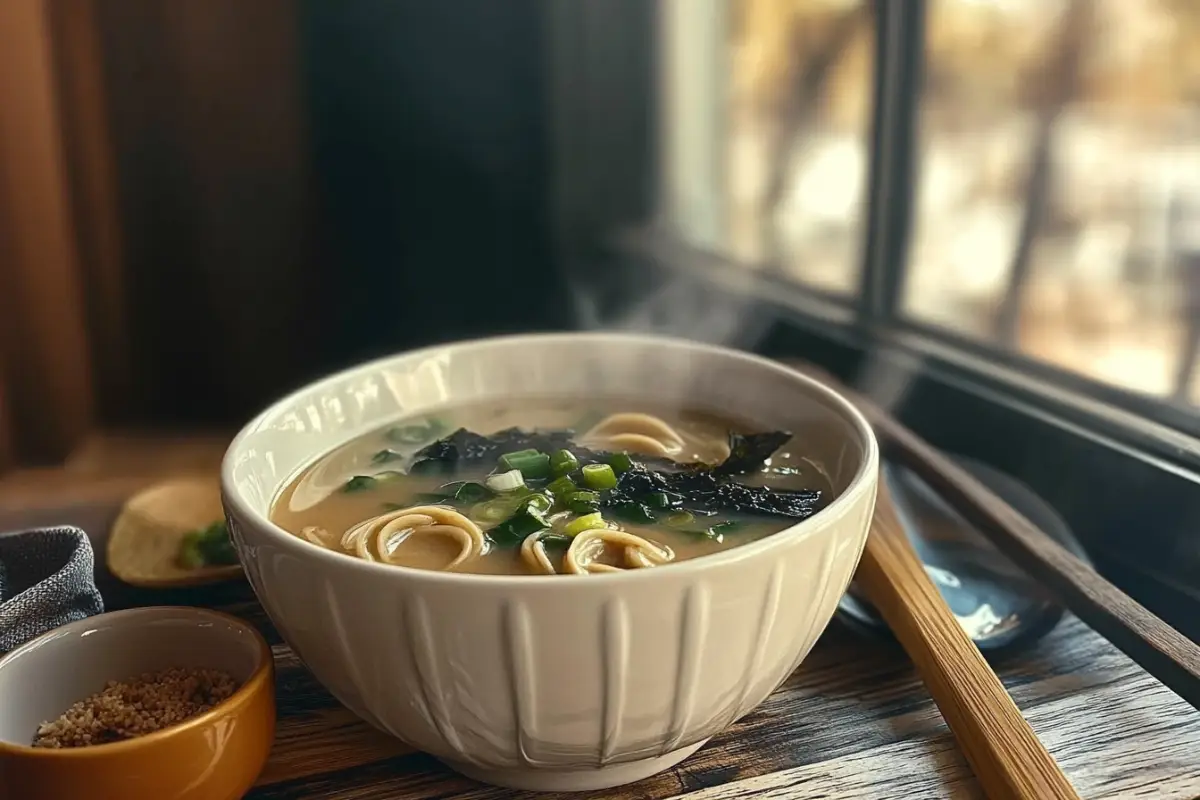



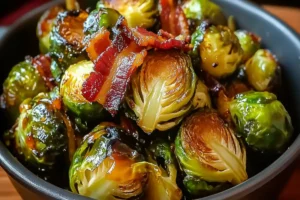

1 thought on “Mushroom Miso Soup: 5 Quick Ways to Make It Perfect”